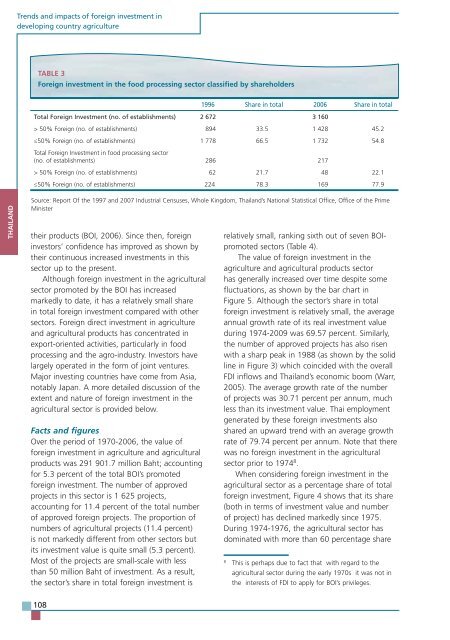TRENDS AND IMPACTS OF FOREIGN INVESTMENT IN DEVELOPING COUNTRY AGRICULTURE
TRENDS AND IMPACTS OF FOREIGN INVESTMENT IN DEVELOPING COUNTRY AGRICULTURE
TRENDS AND IMPACTS OF FOREIGN INVESTMENT IN DEVELOPING COUNTRY AGRICULTURE
You also want an ePaper? Increase the reach of your titles
YUMPU automatically turns print PDFs into web optimized ePapers that Google loves.
THAIL<strong>AND</strong><br />
Trends and impacts of foreign investment in<br />
developing country agriculture<br />
TABLE 3<br />
Foreign investment in the food processing sector classified by shareholders<br />
Source: Report Of the 1997 and 2007 Industrial Censuses, Whole Kingdom, Thailand’s National Statistical Office, Office of the Prime<br />
Minister<br />
their products (BOI, 2006). Since then, foreign<br />
investors’ confidence has improved as shown by<br />
their continuous increased investments in this<br />
sector up to the present.<br />
Although foreign investment in the agricultural<br />
sector promoted by the BOI has increased<br />
markedly to date, it has a relatively small share<br />
in total foreign investment compared with other<br />
sectors. Foreign direct investment in agriculture<br />
and agricultural products has concentrated in<br />
export-oriented activities, particularly in food<br />
processing and the agro-industry. Investors have<br />
largely operated in the form of joint ventures.<br />
Major investing countries have come from Asia,<br />
notably Japan. A more detailed discussion of the<br />
extent and nature of foreign investment in the<br />
agricultural sector is provided below.<br />
Facts and figures<br />
Over the period of 1970-2006, the value of<br />
foreign investment in agriculture and agricultural<br />
products was 291 901.7 million Baht; accounting<br />
for 5.3 percent of the total BOI’s promoted<br />
foreign investment. The number of approved<br />
projects in this sector is 1 625 projects,<br />
accounting for 11.4 percent of the total number<br />
of approved foreign projects. The proportion of<br />
numbers of agricultural projects (11.4 percent)<br />
is not markedly different from other sectors but<br />
its investment value is quite small (5.3 percent).<br />
Most of the projects are small-scale with less<br />
than 50 million Baht of investment. As a result,<br />
the sector’s share in total foreign investment is<br />
108<br />
1996 Share in total 2006 Share in total<br />
Total Foreign Investment (no. of establishments) 2 672 3 160<br />
> 50% Foreign (no. of establishments) 894 33.5 1 428 45.2<br />
≤50% Foreign (no. of establishments)<br />
Total Foreign Investment in food processing sector<br />
1 778 66.5 1 732 54.8<br />
(no. of establishments) 286 217<br />
> 50% Foreign (no. of establishments) 62 21.7 48 22.1<br />
≤50% Foreign (no. of establishments) 224 78.3 169 77.9<br />
relatively small, ranking sixth out of seven BOIpromoted<br />
sectors (Table 4).<br />
The value of foreign investment in the<br />
agriculture and agricultural products sector<br />
has generally increased over time despite some<br />
fluctuations, as shown by the bar chart in<br />
Figure 5. Although the sector’s share in total<br />
foreign investment is relatively small, the average<br />
annual growth rate of its real investment value<br />
during 1974-2009 was 69.57 percent. Similarly,<br />
the number of approved projects has also risen<br />
with a sharp peak in 1988 (as shown by the solid<br />
line in Figure 3) which coincided with the overall<br />
FDI inflows and Thailand’s economic boom (Warr,<br />
2005). The average growth rate of the number<br />
of projects was 30.71 percent per annum, much<br />
less than its investment value. Thai employment<br />
generated by these foreign investments also<br />
shared an upward trend with an average growth<br />
rate of 79.74 percent per annum. Note that there<br />
was no foreign investment in the agricultural<br />
sector prior to 1974 8 .<br />
When considering foreign investment in the<br />
agricultural sector as a percentage share of total<br />
foreign investment, Figure 4 shows that its share<br />
(both in terms of investment value and number<br />
of project) has declined markedly since 1975.<br />
During 1974-1976, the agricultural sector has<br />
dominated with more than 60 percentage share<br />
8 This is perhaps due to fact that with regard to the<br />
agricultural sector during the early 1970s it was not in<br />
the interests of FDI to apply for BOI’s privileges.


